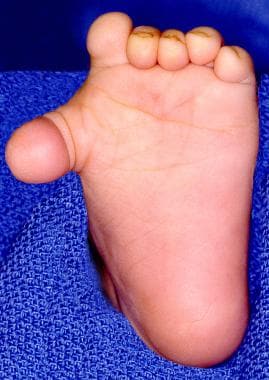Practice Essentials
Polydactyly is the most common congenital anomaly of the forefoot. [1, 2, 3, 4, 5, 6, 7, 8] It most commonly refers to the presence of six toes on one foot, but more toes are possible.
Polydactyly may be associated with syndactyly. It most frequently occurs as an isolated trait with autosomal dominant inheritance and variable penetrance. Other patterns of inheritance, [9] sporadic occurrence, and association with syndromes are also possible. [3, 10, 11]
Accurate understanding of the involved anatomy leads to better clinical results. Radiographs obtained after ossification of the involved bones allow for definitive treatment of the duplicated parts and all associated abnormalities. Greater appreciation of the longitudinal bracket epiphysis, often seen in the first metatarsal in children with preaxial polydactyly, and descriptions that allow for earlier diagnosis and correction of this abnormality lead to better outcomes.
Treatment for polydactyly of the foot has changed little over time. Removing the extra digit through disarticulation is the standard treatment. [5, 12, 13, 14, 15]
Pathophysiology
Polydactyly may be divided into three broad categories as follows:
-
Postaxial polydactyly (lateral ray)
-
Preaxial polydactyly (medial)
-
Central polydactyly [16]
Postaxial polydactyly is the most common form, [7] occurring in 80% of cases, followed by preaxial polydactyly (see the image below) and then central polydactyly (~6% [15] ). The duplication may range from a well-formed articulated digit to a rudimentary digit. Abnormalities of the associated metatarsal commonly occur in polydactyly.
 Preoperative photograph of a 1-year-old child with preaxial polydactyly and significant varus of the duplicated toe.
Preoperative photograph of a 1-year-old child with preaxial polydactyly and significant varus of the duplicated toe.
Other, more detailed classification systems have also been described (see Presentation).
Etiology
Polydactyly may occur as an isolated trait or in conjunction with certain syndromes, and there is a positive family history in 30% of cases. The syndromes with which polydactyly has been associated include Ellis-van Creveld syndrome, [17, 18] trisomy 13, tibial hemimelia, and trisomy 21.
Polydactyly is mostly inherited as an autosomal dominant entity with variable penetrance. [19] At least 10 loci and six genes have been identified as causing nonsyndromic polydactyly in humans, including ZNF141, GLI3, [20] MIPOL1, IQCE, PITX1, and GLI1. [21]
Adam et al observed clinical findings in 18 cases of diabetic embryopathy and preaxial hallucal polydactyly to identify the features most suggestive of diabetic embryopathy. [22] They found that proximally placed preaxial hallucal polydactyly, particularly when coupled with segmentation anomalies of the spine and tibial hemimelia, is highly suggestive of diabetic embryopathy. They added that diabetes in the mothers pointed to a possible genetic predisposition interacting with teratogenic effects of poor glycemic control.
Epidemiology
The incidence of polydactyly is 1.7 cases per 1000 live births. The frequency is higher in blacks (3.6-13.9 cases per 1000 live births) than in whites (0.3-1.3 cases per 1000 live births). Polydactyly is bilateral in 50% of cases and has a slight male predilection.
According to a multicenter birth defects study, the incidence of isolated postaxial polydactyly has ranged from 6.08 per 10,000 population in Argentinians to 225 per 10,000 in Nigerians. [23] It affects males more often than females, hands more often than feet, and left limbs more often than right limbs.
Prognosis
Burger et al assessed health-related quality of life (HR-QoL) in children with preaxial polydactyly of the foot, adults with preaxial polydactyly, children with postaxial polydactyly, and healthy control subjects. [24] The primary outcome was difference in the foot-specific quality of life (FS-QoL); the secondary outcome was difference in general HR-QoL according to the Pediatric Quality of Life Inventory (PedsQL). Children and adults with preaxial polydactyly scored the same in all domains. The Oxford Ankle and Foot Questionnaire (OxAFQ-c) and the PedsQL physical domain showed worse outcomes in children with preaxial polydactyly than in healthy controls and those with postaxial polydactyly.
-
The Venn-Watson classification of polydactyly is based on the anatomic configuration of the metatarsal and the duplicated bony parts.
-
Postaxial polydactyly in a 1-year-old child. In this case, the duplicated sixth toe was excised (dotted line), and the broad distal fifth metatarsal was narrowed.
-
Postoperative view of 1-year-old child who had postaxial polydactyly and excision of the sixth toe demonstrates a good result with straight lateral border.
-
Preoperative photograph of a 1-year-old child with preaxial polydactyly and significant varus of the duplicated toe.
-
Postoperative radiograph of a 1-year-old child with preaxial polydactyly who had significant varus of the duplicated toe demonstrates a good result after resection and metatarsal narrowing.
-
Preaxial polydactyly with longitudinal bracket epiphysis.
-
Mother and son with polydactyly. The patterns of deformity are different.
-
Image of an 8-year-old boy with a history of bilateral preaxial polydactyly. He had excision of bilateral duplicated digits at an outside institution.
-
Postoperative radiograph of an 8-year-old boy with a history of bilateral preaxial polydactyly and excision of the duplicated digits at an outside institution. He required additional surgery because of residual deformity. A good result is depicted following combination of the first metatarsal base with the second metatarsal shaft, creating a 5-digit foot.
-
Radiograph depicting a patient who had a history of bilateral preaxial polydactyly and excision of bilateral duplicated digits at an outside institution. He required additional surgery at age 8 years. Good results were obtained following combination of the first metatarsal base with the second metatarsal shaft, creating a 5-digit foot. At 20-year follow-up, the patient is doing well.




